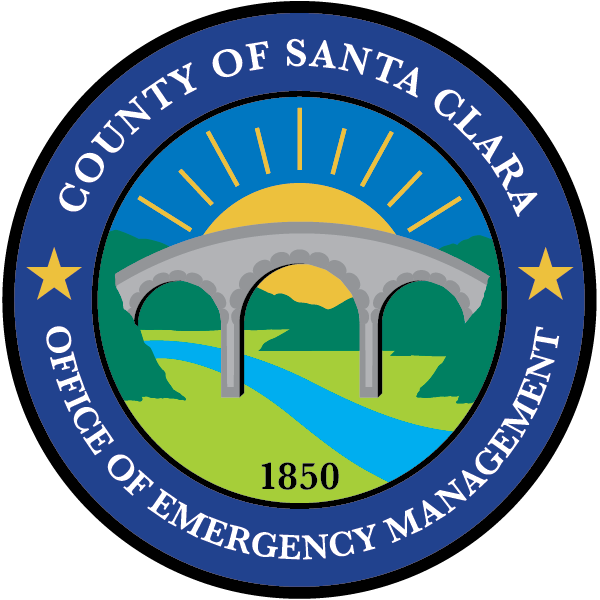The Great California Shakeout Drill
Santa Clara County participates in the annual Great California ShakeOut earthquake drill, when millions of people worldwide participate in earthquake drills at work, school, or home! Prepare to DROP, COVER and HOLD ON! Talk with your family, friends, and neighbors about the Great California ShakeOut and encourage their participation from wherever they are.
We encourage our community members and partners to sign up for the Great California ShakeOut drill by visiting www.shakeout.org.
Your Earthquake Risks
Here in California, earthquakes can happen at any time. In Santa Clara County, our residents live within a 10-mile radius of a major fault line. The San Andreas Fault runs along the Sonoma Coast through the Santa Cruz Mountains, the Hayward Fault along the hills on the east side of the San Francisco Bay, and the Calaveras Fault runs from the eastern region of our County down through the southern end.
Preparedness measures that we can take include ensuring that our homes are secure. Simple, no-cost actions we can take include moving heavy objects down to the floor or lower shelves and not hanging heavy things over our beds and sofas. Low-cost actions include securing our cabinets and drawers with safety latches to keep dishes from falling out, and large appliances and furniture are securely fastened to wall studs or bolted down. Ask for help from your utility company to check gas lines.
Earthquake Outlook for the San Francisco Bay Region (PDF)
Download a copy of Staying Safe Where the Earth Shakes - Bay Area Edition
Earthquake Ready in 4 Steps
- Sign up for AlertSCC at www.AlertSCC.org
- Make a plan
- Build an emergency supply kit
- Help family, friends and neighbors
Before an Earthquake
We can prepare now by ensuring that our homes are earthquake ready. No-cost actions we can take include moving heavy objects from top shelves down to the lower shelves or floor and not hanging heavy objects over our beds and sofas. Low-cost actions include securing our cabinets and drawers, adding safety latches to keep cups and dishes from falling out, and securely fastening large appliances and furniture to wall studs or bolting them down.
Steps we can take to be earthquake ready:
- Securing our space by identifying hazards and securing moveable items such as furniture and other heavy objects to avoid injuries and damage.
- Planning to be safe by creating a disaster plan and deciding how you will communicate in an emergency. Where will you meet your family? How will you get to work? Do you know how to perform CPR or use a fire extinguisher?
- Organizing disaster supplies by packing our Go Bags, an emergency supply kit for when we are required to evacuate immediately.
- Minimizing financial hardship by organizing important documents, strengthening our property, and considering insurance.
- Practicing Drop, Cover, and Hold On so that we know what to do when an earthquake strikes.
- Improving safety after earthquakes by evacuating, helping the injured if possible, and being ready for aftershocks.
- Reconnecting and restoring by checking in with family, friends, and neighbors, repairing damage, and rebuilding your community.


During an Earthquake
When the ground starts shaking, immediately drop to the ground - cover your head and shoulders with your hands, crawl under a sturdy desk or table, and hold on until the shaking stops - remember, DROP, COVER and HOLD ON! If no sturdy shelter is nearby, crawl away from windows next to an interior wall. Stay away from glass, windows, outside doors and walls, and anything that could fall, such as light fixtures or furniture.
Stay where you are until the shaking stops. Do not run outside. Do not get in a doorway, as this does not provide protection from falling or flying objects, and you may be unable to remain standing. If you are in bed: Stay there and cover your head and neck with a pillow. At night, hazards and debris are difficult to see and avoid; attempts to move in the dark result in more injuries than remaining in bed.
After an Earthquake
Be prepared to DROP, COVER and HOLD ON for aftershocks.
The moment the ground stops shaking, it is important to act quickly and safely. Look around to identify any new hazards such as leaking gas lines, damage to the building, downed water or electric lines, or other things that may be dangerous. Always remember that your safety comes first! When you are safe, you will be better positioned to help others.
- Put out any small fires you see in your home with a fire extinguisher.
- Shut off the main gas valve, and do not use candles or matches if you suspect a gas leak.
- Shut off power at the main breaker and leave it off until repaired.
- Unplug any broken lights or appliances as they could cause fires when power is restored.
- Consider all downed power lines as LIVE and stay clear. Do not touch with your hands or other objects.
- Open cabinets and cupboards slowly as items may have shifted.
- Use extreme caution cleaning up any spilled medicines, drugs, or other non-toxic substances. Potentially harmful materials such as bleach, lye, garden chemicals, gasoline, or other petroleum products should be isolated or covered with an absorbent such as dirt or cat litter. When in doubt, leave your home.
- Check for damaged masonry, such as chimneys and walls made of brick or cement blocks.
Earthquake Resources
Get earthquake warnings before an earthquake by downloading the MyShake App.
Look for hazards in your area with the Cal OES MyHazards Tool.
Find where the latest earthquakes occurred by visiting U.S. Geological Survey.
Earthquake resources and information from Ready.gov/earthquakes.
Participate in the Great California ShakeOut earthquake drill.
Join the Earthquake Country Alliance.
Learn more about the services provided by the American Red Cross.
Get earthquake insurance provided by the California Earthquake Authority.
